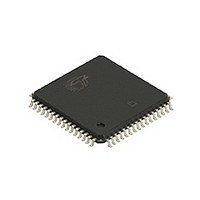CY7C4285-10ASI Cypress Semiconductor Corp, CY7C4285-10ASI Datasheet - Page 15

CY7C4285-10ASI
Manufacturer Part Number
CY7C4285-10ASI
Description
Manufacturer
Cypress Semiconductor Corp
Datasheet
1.CY7C4285-10ASI.pdf
(21 pages)
Specifications of CY7C4285-10ASI
Configuration
Dual
Density
1.125Mb
Access Time (max)
8ns
Word Size
18b
Organization
64Kx18
Sync/async
Synchronous
Expandable
Yes
Bus Direction
Uni-Directional
Package Type
TQFP
Clock Freq (max)
100MHz
Operating Supply Voltage (typ)
5V
Operating Supply Voltage (min)
4.5V
Operating Supply Voltage (max)
5.5V
Supply Current
55mA
Operating Temp Range
-40C to 85C
Operating Temperature Classification
Industrial
Mounting
Surface Mount
Pin Count
64
Lead Free Status / Rohs Status
Not Compliant
Architecture
The CY7C4275/85 consists of an array of 32K/64K words of
18 bits each (implemented by a dual-port array of SRAM cells),
a read pointer, a write pointer, control signals (RCLK, WCLK,
REN, WEN, RS), and flags (EF, PAE, HF, PAF, FF). The
CY7C4275/85 also includes the control signals WXI, RXI, WXO,
RXO for depth expansion.
Resetting the FIFO
Upon power-up, the FIFO must be reset with a Reset (RS)
cycle. This causes the FIFO to enter the Empty condition signified by
EF being LOW. All data outputs go LOW after the falling edge of RS
only if OE is asserted. In order for the FIFO to reset to its default state,
the user must not read or write while RS is LOW.
FIFO Operation
When the WEN signal is active (LOW), data present on the D
pins is written into the FIFO on each rising edge of the WCLK signal.
Similarly, when the REN signal is active LOW, data in the FIFO mem-
ory will be presented on the Q
ed on each rising edge of RCLK while REN is active LOW and OE is
LOW. REN must set up t
function. WEN must occur tENS before WCLK for it to be a valid write
function.
An output enable (OE) pin is provided to three-state the Q
puts when OE is deasserted. When OE is enabled (LOW), data in the
output register will be available to the Q
vices are cascaded, the OE function will only output data on the FIFO
that is read enabled.
The FIFO contains overflow circuitry to disallow additional
writes when the FIFO is full, and under flow circuitry to disallow
additional reads when the FIFO is empty. An empty FIFO
maintains the data of the last valid read on its Q
even after additional reads occur.
Programming
The CY7C4275/85 devices contain two 16-bit offset registers.
Data present on D
distance from Empty (Full) that the Almost Empty (Almost Full) flags
become active. If the user elects not to program the FIFO’s flags, the
default offset values are used (see Table 2). When the Load LD pin
is set LOW and WEN is set LOW, data on the inputs D
into the Empty offset register on the first LOW-to-HIGH transition of
the write clock (WCLK). When the LD pin and WEN are held LOW
then data is written into the Full offset register on the second
LOW-to-HIGH transition of the write clock (WCLK). The third transi-
tion of the write clock (WCLK) again writes to the Empty offset register
(see Table 1). Writing all offset registers does not have to occur at
one time. One or two offset registers can be written and then, by bring-
ing the LD pin HIGH, the FIFO is returned to normal read/write oper-
Note:
Document #: 38-06008 Rev. *A
36. The same selection sequence applies to reading from the registers. REN is enabled and read is performed on the LOW-to-HIGH transition of RCLK.
0–15
ENS
during a program write will determine the
0–17
before RCLK for it to be a valid read
outputs. New data will be present-
0–17
outputs after t
0–15
0–17
OE
0–17
is written
outputs
. If de-
0–17
out-
ation. When the LD pin is set LOW, and WEN is LOW, the next offset
register in sequence is written.
The contents of the offset registers can be read on the output
lines when the LD pin is set LOW and REN is set LOW; then, data
can be read on the LOW-to-HIGH transition of the read clock (RCLK).
Table 1. Write Offset Register
Flag Operation
The CY7C4275/85 devices provide five flag pins to indicate
the condition of the FIFO contents. Empty and Full are syn-
chronous. PAE and PAF are synchronous if V
V
Full Flag
The Full Flag (FF) will go LOW when device is Full. Write operations
are inhibited whenever FF is LOW regardless of the state of WEN.
FF is synchronized to WCLK, i.e., it is exclusively updated by each
rising edge of WCLK.
Empty Flag
The Empty Flag (EF) will go LOW when the device is empty. Read
operations are inhibited whenever EF is LOW, regardless of the state
of REN. EF is synchronized to RCLK, i.e., it is exclusively updated by
each rising edge of RCLK.
Programmable Almost Empty/Almost Full Flag
The CY7C4275/85 features programmable Almost Empty and
Almost Full Flags. Each flag can be programmed (described
in the Programming section) a specific distance from the cor-
responding boundary flags (Empty or Full). When the FIFO
contains the number of words or fewer for which the flags have
been programmed, the PAF or PAE will be asserted, signifying that
the FIFO is either Almost Full or Almost Empty. See Table 2 for a
description of programmable flags.
When the SMODE pin is tied LOW, the PAF flag signal transition is
caused by the rising edge of the write clock and the PAE flag transition
is caused by the rising edge of the read clock.
LD
SS
0
0
1
1
.
WEN
0
1
0
1
WCLK
[36]
Writing to offset registers:
Empty Offset
Full Offset
No Operation
Write Into FIFO
No Operation
Selection
CC
CY7C4275
CY7C4285
/SMODE is tied to
Page 15 of 21
[+] Feedback











